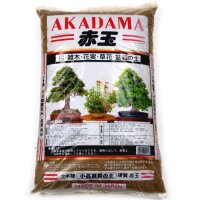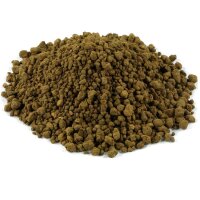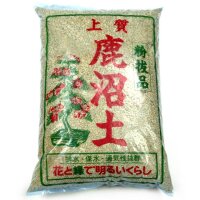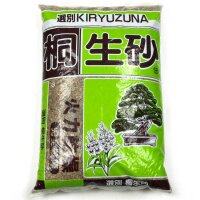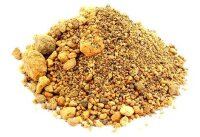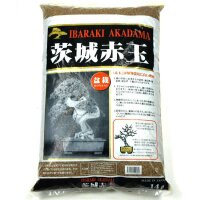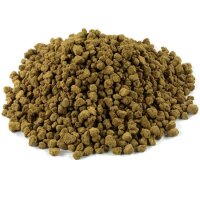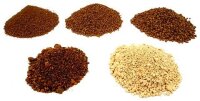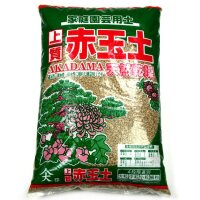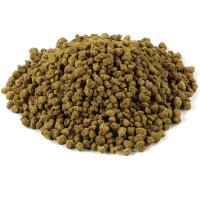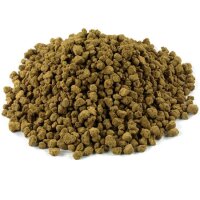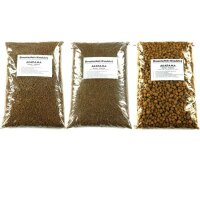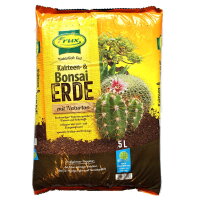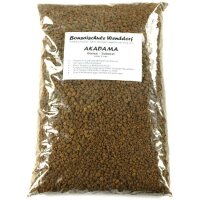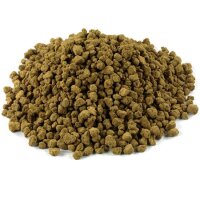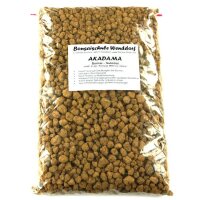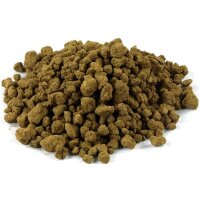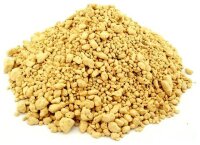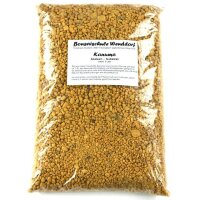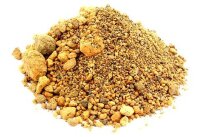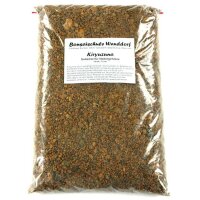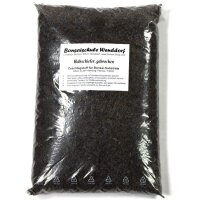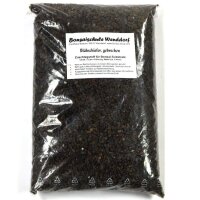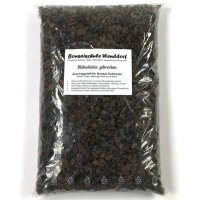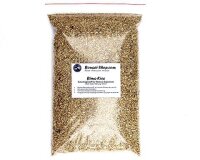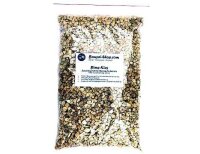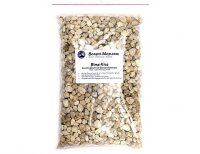Bonsai soil
Akadama Kanuma Kiryu Pumice gravel Bonsai substrates
Proper bonsai soil is critical for the health of bonsai trees. Tried and tested millions of times Japanese bonsai soils (Akadama, Kanuma, Kiryu) meet all requirements. We offer them in different grain sizes and packaging. They are suitable for repotting of your outdoor bonsai as well as for indoor bonsai.
Which bonsai soil have proven themselves in bonsai care ?
- Akadama: Popular japanese bonsai soil, is commonly used and suitable for almost all bonsai
- Kanuma: Very acidic bonsai substrate, best suited for azalea bonsai and all other Rhododendron plants
- Kiryuzuna: Bonsai soil from Japan. Is preferably used for pines bonsai and juniper bonsai. Also for earth mixtures
- Pumice gravel: Bonsai substrates for soil mixtures. Will used sometimes for rooting of collected yamadori bonsai
- Expanded slate: Substrate for soil mixtures. Also used for rooting collected prebonsai
What is a bonsai soil ?
Bonsai soil - this term often refers to something found in the garden: Very fine, rich in humus, often loamy, with rotting components. Experienced bonsai enthusiasts usually use substrates as bonsai soil which are not fine, contain hardly any humus and usually few rotting components. And because a good bonsai soil has very little to do with a gardening soil, bonsai enthusiasts often use the term bonsai substrate.
A bonsai as a miniature tree stands in a bonsai pot often for many years without changing the bonsai substrate. Over this long period, bonsai soil must ensure an optimal supply of nutrients, oxygen and water. A commercial garden soil or even potting soil is not suitable. If you use such fine plant soils your bonsai will be damaged in most cases.
Whether bonsai soil or bonsai substrate is not quite so important. But the quality must be right. Here in the shop you can purchase the bonsai substrate which are fine for your bonsai tree.
Video: What is a well-permeable bonsai soil (in German) ?
A typical beginner's mistake in bonsai care is to use bonsai soil that is too fine. Here we show what a well-drained soil is
Click here to get an overview of our other bonsai videos Bonsai videos
Which requirements must a bonsai soil fulfil ?
A bonsai soil must guarantee an optimal supply of nutrients, oxygen and water to the bonsai. Over a long period - usually 3-5 years. A commercial potting soil from the garden market is not suitable. Such gardening soils, especially potting soils, are too fine. Your bonsai may be damaged.
Bonsai soils, bonsai substrates and soil mixtures should meet the following requirements:
- Good drainage of the bonsai soil with good water retention capacity at the same time
- A good stability for the bonsai must be guaranteed by the bonsai soil
- Bonsai stand partly for a long time in a bonsai soil. Therefore, a high buffer capacity is important
- Sufficient nutrient content should be available
- Good crumb structure = good aeration = prevention of root rot
If these conditions are fulfilled by a bonsai soil, a healthy soil life can develop, the oxygen supply in the root area is guaranteed and the nutrients are available for the plant in a suitable form.
What characteristics must a good bonsai soil have ?
If you want to buy a bonsai soil you should pay attention to the grain size, a good permeability to water and air, to the ability to hold water and to pay attention to the pH value.
- Grain size: Bonsai soils should not be too fine. The coarser a bonsai substrate is the more oxygen is in the soil. And that's very important for the bonsai. Root cells need oxygen. If there is too little of it in the soil, the roots and in consequence the tree will develop badly. In fine, compact bonsai soils the roots can even die from lack of oxygen. Therefore: Hands off very fine bonsai soil. It is only suitable in a few cases (for example to cover the surface).
- Drainage: A bonsai must be well drained for water. The water should drain quickly. If it remains in the pot (usually because the substrate is too fine), oxygen deficiency often occurs. If after pouring of the bonsai the water drips out well and quickly it draws air into the substrate. The roots will thank you. Do not be afraid that the bonsai will dry up. A bonsai tree can hadle dryness well if it really occurs in a good bonsai soil. The tree closes the stomata and restricts the evaporation. It can not defend himself against too little oxygen in the soil. Another disadvantage of too much water in the soil: The soil temperature rises only slowly. As a result, the roots grow slower and limit the growth of the bonsai. Both are not desired.
- Water-holding ability: Even if the water (from the pores between the soil particles) should run well, a bonsai soil must be able to hold a sufficient amount of water at the same time. Porous substrates such as Akadama and Kanuma can hold enough water despite good drainage to provide the water to the bonsai between pouring well.
- pH value: The pH value in the soil is influenced by the earth itself, decomposition processes of parts of plants, the irrigation water and especially the fertilization. pH can change. When the pH drops from neutral pH7 to pH6, the concentration of hydrogen ions increases tenfold. This is very important for the plant. Especially with plants like our bonsai which stand in the same substrate for a long time. Therefore, it is important that a good bonsai soil can buffer the pH. The Akadama bonsai soil can do this very well.
- Bonsai soil mixtures: You can mix a bonsai soil yourself. The internet is full of recipes for composition of bonsai soil mixtures. However, since there are good and usually affordable, bonsai soils for all conceivable purposes to buy, we would like to advise against it. Why should you invent the wheel twice ? In most of these bonsai soil mixtures the good properties of a bonsai soil (e.g., coarser graining) are diluted with the bad properties of another (e.g., fine graining). Without a clear advantage. Established bonsai soils like Akadama, Kanuma and Kiryu have everything a bonsai soil needs. These bonsai soils from Japan have been tested millions of times and have proven their worth. If you still want to mix your own bonsai soil, please make sure at least that the grain sizes are not too fine. Bonsai soil mixtures must always ensure good drainage and ventilation.
What are the main components of bonsai soils ?
Bonsai and potting soil often consist of different components. Especially if they are mixed together. The following overview shows the general components and properties of bonsai or potting soils
- Clay: Formed from primary rocks of volcanic origin (such as granite, porphyry) through weathering. The fine basic components adhere firmly to each other so that the clay can absorb only a little water. It is rich in nutrients, especially in trace elements. Pure clay is not very suitable for the cultivation of bonsai.
- Sand: Consists of quartz particles (up to approx. 2mm in diameter) and possesses no nutrients. Sand can only store small amounts of water. Pure sand is not suitable for cultivating most plants. Different types of sand can be used (for example, building sand or powdered granite / porphyry = rock sand). It should be noted that it should not be too fine (do not use sea sand or aquarium sand) or too sharp-edged (different stone sands) should be. Burnt clay (in the form of small balls) can be put under the category of sand, although its water storage capacity is usually much better.
- Loam: Mixture of different proportions of sand and clay. The ability to absorb and release water is good and most suitable for plants. Clay contains many nutrients.
- Peat: Formed from peat moss. This constantly grows in stagnant water. The lower layers die off and are compressed under air exclusion. This forms humic acid which has a preservative effect on the plant remains and prevents rotting or putrefaction. As a result, it does not come to the conversion into nutrients, so the peat is very nutrient poor and acidic (pH 2-4).
- Mulch: Consists of shredded, dried plant parts (bark, leaves, coarse sawdust). As an admixture to growing media it loosens up the soil. Usually used to cover beds (weed development is inhibited).
- Humus: Formed by rotting plant and microorganism, i. organic substances under the influence of air, moisture and various soil organisms. All nutrients are preserved. Humus ensures a good ventilation of the soil and promotes the crumb structure of the soil. It can develop a rich soil life, the nutrients are available to the plants and water is stored. All this leads to a promotion of rooting. Humus alone is a very good substrate for many plants.
- Humus production: Crushed plant parts are piled up for rent, covered with some soil and slightly moistened. After a short time inside develop temperatures of about 50-70°C. The plant residues (mainly cellulose) are converted to inorganic elements (e.g., nitrates, phosphates, sulfates, etc.). In addition to bacteria, fungi and other soil organisms are involved in this process. After about 2 months, this process is completed. The next months (up to 2 years), the humus must be implemented regularly every 2 months. This is important for a good oxygen supply, otherwise it comes to decay processes. Possibly during this time, the humus must be slightly moistened and neutralized by adding a little bit of lime.

